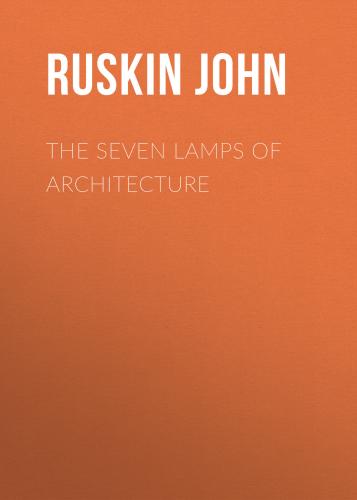PLATE II.—(Page 55—Vol. V.)
Part of the Cathedral of St. Lo, Normandy.
XIX. The last form of fallacy which it will be remembered we had to deprecate, was the substitution of cast or machine work for that of the hand, generally expressible as Operative Deceit.
There are two reasons, both weighty, against this practice; one, that all cast and machine work is bad, as work; the other, that it is dishonest. Of its badness, I shall speak in another place, that being evidently no efficient reason against its use when other cannot be had. Its dishonesty, however, which, to my mind, is of the grossest kind, is, I think, a sufficient reason to determine absolute and unconditional rejection of it.
Ornament, as I have often before observed, has two entirely distinct sources of agreeableness: one, that of the abstract beauty of its forms, which, for the present, we will suppose to be the same whether they come from the hand or the machine; the other, the sense of human labor and care spent upon it. How great this latter influence we may perhaps judge, by considering that there is not a cluster of weeds growing in any cranny of ruin which has not a beauty in all respects nearly equal, and, in some, immeasurably superior, to that of the most elaborate sculpture of its stones: and that all our interest in the carved work, our sense of its richness, though it is tenfold less rich than the knots of grass beside it; of its delicacy, though it is a thousand fold less delicate; of its admirableness, though a millionfold less admirable; results from our consciousness of its being the work of poor, clumsy, toilsome man. Its true delightfulness depends on our discovering in it the record of thoughts, and intents, and trials, and heart-breakings—of recoveries and joyfulnesses of success: all this can be traced by a practised eye; but, granting it even obscure, it is presumed or understood; and in that is the worth of the thing, just as much as the worth of anything else we call precious. The worth of a diamond is simply the understanding of the time it must take to look for it before it can be cut. It has an intrinsic value besides, which the diamond has not (for a diamond has no more real beauty than a piece of glass); but I do not speak of that at present; I place the two on the same ground; and I suppose that hand-wrought ornament can no more be generally known from machine work, than a diamond can be known from paste; nay, that the latter may deceive, for a moment, the mason's, as the other the jeweller's eye; and that it can be detected only by the closest examination. Yet exactly as a woman of feeling would not wear false jewels, so would a builder of honor disdain false ornaments. The using of them is just as downright and inexcusable a lie. You use that which pretends to a worth which it has not; which pretends to have cost, and to be, what it did not, and is not; it is an imposition, a vulgarity, an impertinence, and a sin. Down with it to the ground, grind it to powder, leave its ragged place upon the wall, rather; you have not paid for it, you have no business with it, you do not want it. Nobody wants ornaments in this world, but everybody wants integrity. All the fair devices that ever were fancied, are not worth a lie. Leave your walls as bare as a planed board, or build them of baked mud and chopped straw, if need be; but do not rough-cast them with falsehood.
Конец ознакомительного фрагмента.
Текст предоставлен ООО «ЛитРес».
Прочитайте эту книгу целиком, купив полную легальную версию на ЛитРес.
Безопасно оплатить книгу можно банковской картой Visa, MasterCard, Maestro, со счета мобильного телефона, с платежного терминала, в салоне МТС или Связной, через PayPal, WebMoney, Яндекс.Деньги, QIWI Кошелек, бонусными картами или другим удобным Вам способом.
